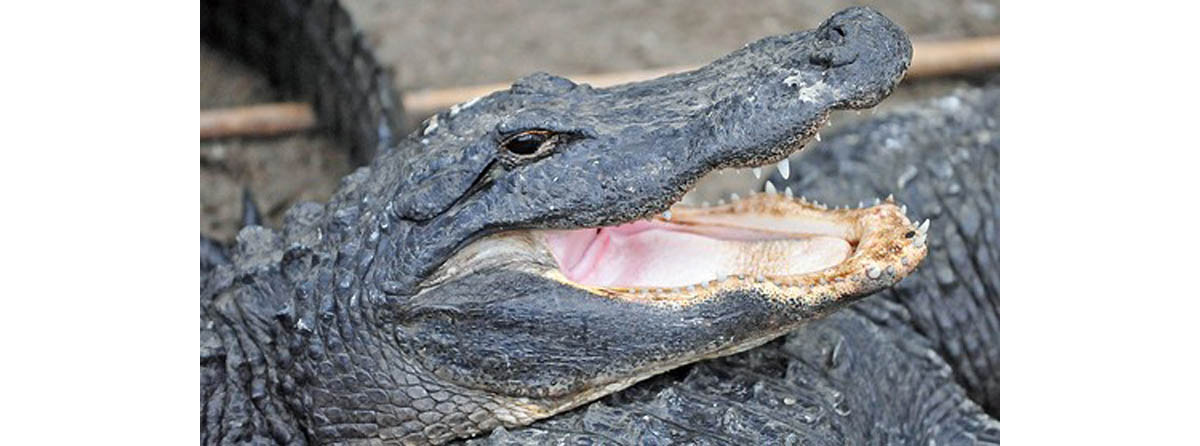Did you know that the most valuable tooth in history was one of physicist Sir Isaac Newton’s? It was set in a ring and sold in 1816 for the equivalent of nearly $36,000 in today’s money.

But most of us consider our teeth to be most valuable when firmly in our jaws, to be displayed in a dazzling smile. But despite rates of tooth decay decreasing since the introduction of fluoride toothpaste and better oral hygiene, a quarter of people over 60 have lost all of their teeth.
This is bad news for us, as unlike animals such as the alligator, we cannot replace our adult teeth with real teeth – once they’re gone, they’re really gone, and can only be replaced with artificial ones. (There was a nasty period in history when they tried transplanting dead people’s teeth into the mouths of the rich and famous, but fortunately that trend died – along with the teeth).
Tooth remnants are the key
Scientists have found that alligators can replace lost teeth because in their jaws they have remnants of dental lamina. This is the primitive forerunner of animal (including human) teeth, which is present from week six in a human fetus, and later becomes tooth enamel.
How does it grow into teeth?
When an alligator loses a tooth a cascade of events is triggered which stimulate the development of the dormant dental lamina into a new tooth. Scientists speculate that this involves signalling between molecules by means of special chemical messengers and the development of stem cells which are basic forerunners of all cells and have the potential to develop into any type of cell.
How could this be translated into humans?
Scientists have closely studied young alligators to try and discover the precise mechanism by which the remnants of dental lamina develop into new teeth. As a result they have been able to grow tooth cells in the laboratory.
Unlike alligators this mechanism is not naturally present in humans, but remnants of the raw material – the dental lamina - do persist in our jaws. Once scientists have discovered precisely what triggers them to develop into new teeth, it is possible that they can use it to help humans grow replacement teeth.
What other applications are there for this research?
In Cleidocranial dysplasia and Gardner’s syndrome, people develop extra ('supernumary'), unwanted teeth. In other people the remnants of dental lamina are abnormally stimulated to grow, forming tumors in the jaws.
One of the researchers explained how understanding the mechanisms triggering tooth development might benefit different groups of people:
What Other Research Is There On Tooth Loss?
Regenerating dental pulp
The center of each of our teeth contains what is known to dentists as the pulp. This is tissue containing the nerves and blood vesselswhich keep the tooth alive and vital.

For example deep cavities caused by decay may allow bacteria in, causing infection. The pulp becomes inflamed, causing it to swell – and as it’s confined inside the hard tooth, this can cut off its blood supply. Similarly trauma like a blow to the tooth may sever these delicate blood vessels. Once the pulp has died off the tooth can become brittle as it dries out, making it fragile and prone to breaking. To preserve it for longer your dentist will carry out root canal therapy on the tooth.
What does this involve?
Your dentist will gain access to the pulp chamber by drilling a hole through the crown (the part visible in the mouth) of the tooth. Some teeth such as those at the front have only one root, whereas others can have up to three. Each root contains pulp, and if all of them are dead the dentist will have to treat all of them.
Opening up the pulp chamber will allow any pus to drain away and the dentist then uses special tools to extract the remaining pulp tissue. He will carefully cleanse and dry the pulp chamber before inserting a filling material. This is not the same material used to fill cavities – usually a rubbery substance called gutta percha is used which is flexible and able to get around any twists and curves in the root. If the pulp chamber is not blocked off in this way bacteria and organic debris will collect in it and set off inflammation again, leading to pain, erosion of bone and eventual loss of the tooth.
New techniques may replace root canal therapy
Current research is directed towards helping the dental pulp to regenerate.
But these techniques are less likely to work in mature adult teeth.
So new work involves the use of stem cells - one group of researchers removed the pulp from dog teeth, extracted the stem cells and then reinjected them in order to regenerate the pulp.
Another group has tried introducing a special protein gel matrix into the pulp chamber, which acts as a growth medium to support blood vessels and nerves.
Tony Smith, professor in oral biology at Birmingham University in the UK commented: ‘The whole concept of going for pulp regeneration is that you will try and retain a vital tooth, a tooth that is alive.’
Once these techniques have been perfected there is every chance that root canal therapy could become a thing of the past.
- Photo courtesy of Phil Snyder by Flickr : www.flickr.com/photos/philsnyder/5332694825/
- Photo courtesy of Heather Paul by Flickr : www.flickr.com/photos/warriorwoman531/8129497135/
- www.myscienceacademy.org/2013/05/17/solving-an-alligator-mystery-may-help-humans-regrow-lost-teeth/
- www.firstwordpharma.com/node/1115713
- www.ncbi.nlm.nih.gov/pmc/articles/PMC3339021/
- www.hindawi.com/journals/ijd/2010/856087/


Your thoughts on this